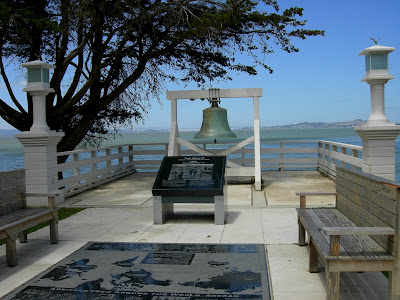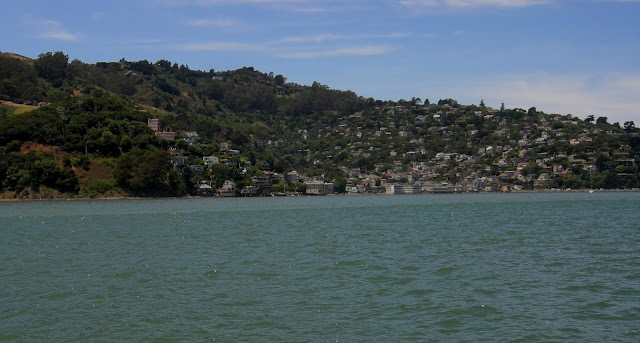 |
| Gateway to a Shimmering City of White |
 |
| Stupendous View from the Marin Headlands |
We wanted to spend some time with family
and friends back home so we rented a car in Sausalito for a day's drive to Portland and then on to Seattle the following day. Before leaving San Francisco, we drove out to the Marin
Headlands on the north side of the Golden Gate Bridge. What a perfect day! So often clouds blow in from the ocean and
shroud “The City” with a blanket of gray. We were
thankful for the blue sky and stupendous views of the Golden Gate Bridge,
Alcatraz Island, and the shimmering City Skyline.
From atop the Headlands we could see The City and its suburbs dressed
in white, sandwiched between blue water and sky; the red bridge and
majestic mountains stand like a mighty gateway. Interestingly, San Francisco Bay was first
sighted by the Spanish explorer Gaspar de Portola from the summit of the 1,200
foot Sweeney Ridge but he hadn't realized what he had found. The first European to actually enter the Bay
was Spanish explorer Juan de Ayala who arrived in 1775 on his ship the San Carlos and moored in a bay of Angel
Island now known as Ayala Cove. After stopping to take in the wonderful views, we
continued our drive through the Marin Headlands out to Point Bonita Lighthouse. As one might guess, the surrounding hillsides
that make up the Headlands are peppered with old battery emplacements; and several
Army camps, that once protected this important harbor, can still be seen near the
entrance of the Bay. The Bonita Lighthouse has stood watch over this gateway for more than 150 years. Visiting the lighthouse is definitely a fun adventure, reached
by hiking a trail out to Bonita Point then walking through a tunnel in the rock face and over a suspended foot bridge to the lighthouse perched on a rock pinnacle. As we walked across the foot bridge looking down at the sea 300 feet below, the bridge began to bounce up and down. Leonard, uncomfortable with heights, quickly made his way across, but I had to stop and take some pictures. This unique lighthouse was the third
lighthouse on the West Coast, completed in 1855 with a second-order Fresnel
lens. The Fresnel lens system was developed in 1822
by French physicist Augustin Fresnel; the system works with ground glass prisms
arranged in rings around a light source.
Fresnel’s invention bends seventy percent of the outgoing bulb light and
focuses it horizontally. There are seven
types of lenses or “orders” each different in size. Navigators can distinguish one lighthouse
from another because each lighthouse has its own pattern of light. Point Bonita’s light switches on for three
seconds, off for one. In dense fog when
the light signal cannot be seen, a sound system is activated. Fog horns are as distinctive as light
signals. Point Bonita sends out two
blasts every 30 seconds. Most boaters
today use electronic charts for navigation but lighthouses still serve as visual landmarks and aids to navigation. We look forward to being back on the boat and seeing many more sights in San Francisco upon our return from Seattle.
 |
| Bonita Point Lighthouse |
 |
| Suspended Foot Bridge to Point Bonita Lighthouse |
 |
| Cables Holding the Foot Bridge in Place |
 |
| Cables Securely Anchored |
 |
| A Long Way Down |


















































